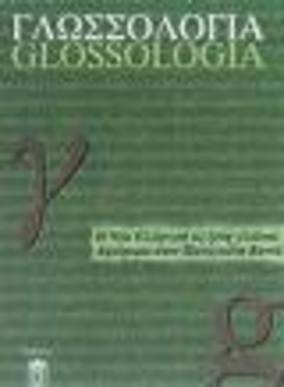Ο Goffman στη γλωσσική επιστήμη : μια κριτική αποτίμηση της προσέγγισής του
Part of : Γλωσσολογία ; Vol.21, 2013, pages 57-74
Issue:
Pages:
57-74
Author:
Abstract:
The focus of the present paper is on Erving Goffman (1922-1982), one of the most perceptive observers of the micro-world of social interaction. More specifically, the paper offers a critical examination of his work from a (socio)linguistic perspective, aiming at clarifying some of his basic concepts that have travelled from sociology to linguistics (i.e. interaction order, self-presentation, role, frame, and footing). The analysis of these notions reveals the influence of his approach on contemporary linguistic thought, as well as his equivocal contribution to the examination of real data. Conversation Analysis (CA) can be proved valuable, since, by building on Goffman’s insightful observations, it provides a recognizable method for approaching empirical data and opens up a whole new perspective on talk-in-interaction.
Subject:
Subject (LC):
Keywords:
αυτο-παρουσίαση, ιδιότητα συμμετοχής στη διεπίδραση, πλαίσιο, ρόλος, τάξη της διεπίδρασης
Notes:
Περιέχει σημειώσεις και βιβλιογραφία
References (1):
- Antaki C., Díaz, F. & Collins, A. 1996. Keeping your footing: Conversational completion in three-partsequences. Journal of Pragmatics 25 (2), 151-171.Benveniste, E. 1971. Problems in General Linguistics (trans. M. E. Meek). Coral Gables, Florida:University of Miami Press.Brown P. & Levinson, S. C. 1987. Politeness: Some Universals in Language Usage. Cambridge:Cambridge University Press.Clayman, S. 1992. Footing in the achievement of neutrality: The case of news-interview discourse. InP. Drew & J. Heritage (eds), Talk at Work: Interaction in Institutional Settings. Cambridge:Cambridge University Press, 163-198.Drew, P. & Heritage, J. 1992. Analyzing talk at work: An introduction. In P. Drew & J. Heritage(eds), Talk at Work: Interaction in Institutional Settings. Cambridge: Cambridge UniversityPress, 3-65.Ensink, T. & Sauer, C. (eds) 2003. Framing and Perspectivising in Discourse.Amsterdam/Philadelphia: John Benjamins.Fine, G. A., Manning, Ph. & Smith, G. W. H. 2000. Introduction. In G. A. Fine & G. W.H. Smith(eds), Erving Goffman. London: Sage, ix-xliv.Goffman, E. 1959. The Presentation of Self in Everyday Life. Harmondsworth, Middlesex: Penguin.Goffman, E. 1961. Encounters: Two Studies in the Sociology of Interaction. Harmondsworth,Middlesex: Penguin.Goffman, E. 1963. Behavior in Public Places: Notes on the Social Organization of Gatherings. NewYork: Free Press.Goffman, E. 1967. Interaction Ritual: Essays on Face-to-Face Behaviour. Harmondsworth,Middlesex: Penguin.Goffman, E. 1972 [1971]. Relations in Public: Microstudies of the Public Order. Harmondsworth,Middlesex: Penguin.Goffman, E. 1974. Frame Analysis: An Essay on the Organization of Experience. New York: Harperand Row.Goffman, E. 1981. Forms of Talk. Oxford: Blackwell.Goffman, E. 1983. The interaction order: American Sociological Association, 1982 Presidentialaddress. American Sociological Review 48 (1), 1-17.Gonos, G. 1977. ‘Situation’ versus ‘frame’: The ‘interactionist’ and the ‘structuralist’ analyses ofeveryday life. American Sociological Review 42 (6), 854-867.Goodwin, C. & Duranti, A. 1992. Rethinking context: An introduction. In A. Duranti & C. Goodwin(eds), Rethinking Context. Cambridge: Cambridge University Press.Καπελλίδη, Χ. 2011. Υποκειµενικότητα και αυτο-παρουσίαση στη γλωσσική διεπίδραση.Αδηµοσίευτη ∆ιδακτορική ∆ιατριβή. Τοµέας Γλωσσολογίας, Τµήµα Φιλολογίας, ΑΠΘ.Kendon, A. 1988. Goffman’s approach to face-to-face interaction. In P. Drew & A. Wooton (eds),Erving Goffman. Exploring the Interaction Order. Cambridge: Polity Press, 14-40.Langacker, R. 1990. Subjectification. Cognitive Linguistics 4 (1), 1-38.Levinson, S. 1988. Putting linguistics on a proper footing: Explorations in Goffman’s concepts ofparticipation. In P. Drew & A. Wootton (eds), Erving Goffman: Exploring the InteractionOrder. Cambridge: Polity Press, 161-227.Littlejohn, St. 2002. Theories of Human Communication. Belmont, CA: Wadsworth.Μακρυνιώτη, ∆. 1996. Εισαγωγή στις Συναντήσεις (µτφρ. ∆. Μακρυνιώτη). Αθήνα: Αλεξάνδρεια.Manning, Ph. 1991. Drama as life: The significance of Goffman’s changing use of the theatricalmetaphor. Sociological Theory 9 (1), 70-86.Manning, Ph. 1992. Erving Goffman and Modern Sociology. Stanford: Stanford University Press.Manning, Ph. 2000 [1989]. Resemblances. Reprinted in G. A. Fine & G. W. H. Smith (eds), ErvingGoffman. Vol. 2. London: Sage, 49-63.Pit, M. 2003. How to Express Yourself with a Causal Connective. Subjectivity and Causal Connectivesin Dutch, German and French. Amsterdam: Rodopi.Rawls, A. 1987. The interaction order sui generis: Goffman’s contribution to social theory.Sociological Theory 5, 136-49.Rawls, A. W. 1989. Language, self and social order: A reformulation of Goffman and Sacks. HumanStudies 12, 147-172.Schegloff, Ε. 1988. Goffman and the analysis of conversation. In P. Drew & A. Wootton (eds), ErvingGoffman: Exploring the interaction order. Cambridge: Polity Press, 89-135.Schegloff, E. 1996. Turn organization: One intersection of grammar and interaction. In E. Ochs, E.Schegloff & S. Thompson (eds), Interaction and Grammar. Cambridge: Cambridge UniversityPress, 52-133.Schiffrin, D. 2006. From linguistic reference to social reality. In A. de Fina, S. Schiffrin, & M.Bamberg (eds), Discourse and Identity. Cambridge: Cambridge University Press 103-131.Tannen, D. (ed.) 1993. Framing in Discourse. Oxford: Oxford University Press.Tannen, D. & Wallat, C. 1993. Interactive frames and knowledge schemas in interaction: Examplesfrom a medical examination/interview. In D. Tannen (ed.), Framing in Discourse. Oxford:Oxford University Press, 57-76.Watzlawick, P., Beavin, J. H. & Jackson, D. D. 1967. Pragmatics of Human Communication: A Studyof Interactional Patterns, Pathologies, and Paradoxes. New York: Norton.Zimmermann, D. 1998. Identity, context and interaction. In C. Antaki & S. Widdicombe (eds),Identities in Talk. London: Sage, 87-106.Williams, R. 1988. Understanding Goffman’s methods. In P. Drew & A. Wootton (eds), ErvingGoffman: Exploring the Interaction Order. Cambridge: Polity Press, 64-88.




